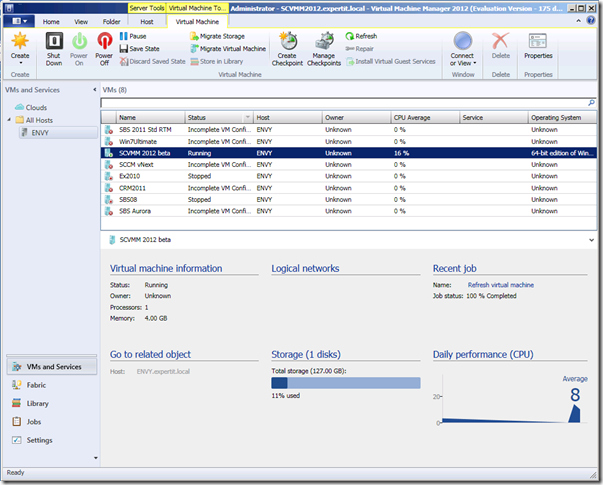6 part SCVMM 2012 Review
Recommended reading if you are not up to speed yet as to what the SCVMM 2012 beast has to offer.
I love when Microsoft takes an already good product and adds a whole lot of new features to make the next version not just better but excellent. This is what’s happening with System Center Virtual Machine Manager (SCVMM) in its new version: 2012, currently in beta, to be released in the second half of 2011. In this article series we’ll take a look at what’s new, what’s improved and introduce the new concepts and capabilities of SCVMM 2012.
What’s new in SCVMM 2012 – Not just VMs anymore
The biggest shift in SCVMM is the change from managing Virtual Machines (VMs) to managing the entire virtualized datacentre. The shift is so dramatic that “System Center Data Centre Manager” might be a more appropriate name. SCVMM can communicate with brand new machines with no OS installed and do a bare metal installation, then configure them in a Hyper-V cluster as well as talk directly to your SAN storage. This then becomes a private cloud inside of SCVMM that abstracts hosts, storage, and networking into a unified pool of computing resources.
Add to this the ability to use Server App-V to deploy applications through SCVMM as well as SQL Server profiles to deploy customised database servers and Dynamic- and Power Optimization. The latter allows SCVMM to turn off host machines when they’re not needed and then turn them back on when the load increases whereas the former allows SCVMM to automatically move VMs between hosts to balance the load. The concept of multiple virtual machines working together (web front end servers, backend database servers) is covered by a services concept where multiple machines can be provisioned in unison; if the load increases scale out with additional VMs can be executed. Network load balancer appliances are also recognised and supported directly in SCVMM. Patching a host cluster is a difficult task as each node has to have its VMs migrated to other hosts, the system patched and rebooted before the process is repeated on the next host. SCVMM now orchestrates cluster host patching as well as integrating with Windows Server Update Services and allowing you to define baselines of patches that each host needs. The list of managed hypervisors has grown, not only does SCVMM manage Hyper-V and VMware, it now manages Citrix Xen server as well, covering all the major hypervisors on the market.
- SCVMM 2012 review – Part 6: Self-service empowerment, service deployment and conclusion
- SCVMM 2012 review – Part 5: Integrating with VMware and Citrix XenServer, Cluster patching
- SCVMM 2012 review – Part 4: Bare Metal Configuration, Dynamic & Power Optimization
- SCVMM 2012 review – Part 3: Logical networks, storage integration
- SCVMM 2012 review – Part 2: Private cloud, library services, security and accounts
- SCVMM 2012 review – Part 1: What is new and installation
Similar Posts:
- How to remove a node from a cluster that is managed by SCVMM 2008 R2
- vWorkspace 7.5 Feature Spotlight: Hyper-V Host Maintenance
- VMMUpdate: Free MS SCVMM update script
- Tuning SCVMM for VDI deployments
- Dynamic Optimization of the Private Cloud Infrastructure

October 19th, 2011 - 10:46
Microsoft are going all out to make up the ground on Vmware. We use Xenserver as our primary Hypervisor as Hyper-V is still a Windows server (which we all know can still crash)… The good news is SCVMM is Hypervisor agnostic to a degree so win win!